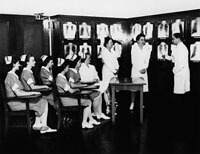 In the 1940s, the nurses’ training program at the University of Colorado became affiliated with National Jewish, bringing nursing students to the hospital for basic and advanced courses in TB nursing. Programs for medical students, residents and physicians were also enhanced, attracting many young and talented people to the hospital.
In the 1940s, the nurses’ training program at the University of Colorado became affiliated with National Jewish, bringing nursing students to the hospital for basic and advanced courses in TB nursing. Programs for medical students, residents and physicians were also enhanced, attracting many young and talented people to the hospital.
After World War II, the hospital was designated by the United Nations World Health Organization as its official United States training site for TB control specialists from all parts of the world, including China, India, Czechoslovakia, the Philippines, England, France and Israel.
Fellowships
With growth and talent dominating the scene at National Jewish in the 1960s, many young physicians throughout the world began to vie for fellowships in the hospital’s training program. In addition to the rotation of medical students from the university through the various services, residencies and fellowships were available in clinical areas, including chest medicine, chest surgery, pediatric chest diseases, or in asthma and allergy. Fellowships were also available in clinical research in cardiovascular physiology and in experimental and clinical pathology.
Throughout the institution, research was intertwined with the training of the next generation of researchers through post-doctoral training programs.
TB Course
In 1963, National Jewish piloted a training program that was soon to become an internationally acclaimed postgraduate course in clinical management and control of TB. This TB Course was to supplement the residency and fellowship program which had already trained thousands.
Professional Education and CME
During the 1990s, professional education opportunities expanded to include more live workshops, high quality printed materials and Web-based interactive training. By 1999, National Jewish had produced more than 90 professional education programs serving 6,000 individuals. Today, these programs reach over 15,000 healthcare professionals annually.
Decade of Innovation
In 2007, the National Jewish board approved a new strategic plan which called attention to personalized healthcare as an emerging trend, enabled by technology, knowledge of genetics and biology, economics and consumerism. Personalized medicine presented opportunities to enable healthcare practices to be increasingly patient-specific by taking into account individual differences in health states, disease processes and outcomes from interventions.
With this strategic plan, a continued emphasis on research and education of the next generation of leaders in medicine and science would ensure that National Jewish remain preeminent in its areas of focus.
Page 1, 2
Read about National Jewish Health's clinical history.
Read about National Jewish Health's history in research.